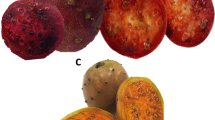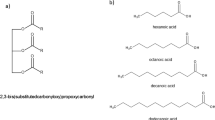Abstract
Turmeric powder (TP) containing approximately 5.15% curcumin was evaluated for reduction of development of high-fat diet-induced obesity. Rats were fed a 30% fat diet containing 5, 10, and 20 g of TP/100 g of diet (TP-5, TP-10, and TP-20 groups) for 30 days. Body weight gain, energy intake, and the visceral fat mass for the TP-10 and TP-20 groups were lower than for the control group. Serum triglyceride and hepatic total lipid levels for the TP-10 and TP-20 groups were lower than for the control group. The hepatic glutathione concentration and the glutathione-S-transferase activity for all TP groups, and the thiobarbituric acid reactive substances level for the TP-20 group, were higher than for the control group. A high dose of turmeric powder apparently reduces development of high-fat diet-induced obesity, but also causes the adverse effect of increasing oxidative stress in rats.
Similar content being viewed by others
References
Ezzati M, Martin H, Skjold S, SV, Murray CJL. Trends in national and state-level obesity in the USA after correction for self-report bias: Analysis of health surveys. J. R. Soc. Med. 99: 250–257 (2006)
Haslam DW, James WP. Obesity. Lancet 366: 1197–1209 (2005)
Despres JP, Lemieux I. Abdominal obesity and metabolic syndrome. Nature 444: 881–887 (2000)
Vega GL, Adams-Huet B, Peshock R, Willett D, Shah B, Grundy SM. Influence of body fat content and distribution on variation in metabolic risk. J. Clin. Endocrinol. Metab. 91: 4459–4466 (2006)
Ammon HP, Wahl MA. Pharmacology of Curcuma longa. Planta Med. 57: 1–7 (1991)
Chattopadhyay I, Biswas K, Bandyopadhyay U, Banerjee RK. Turmeric and curcumin: Biological actions and medicinal applications. Curr. Sci. 87: 44–53 (2004)
Seo KI, Choi MS, Jung UJ, Kim HJ, Yeo J, Jeon SM, Lee MK. Effect of curcumin supplementation on blood glucose, plasma insulin, and glucose homeostasis related enzyme activities in diabetic db/db mice. Mol. Nutr. Food Res. 52: 995–1004 (2008)
Weisberg SP, Leibel R, Tortoriello DV. Dietary curcumin significantly improves obesity-associated inflammation and diabetes in mouse models of diabesity. Endocrinology 149: 3549–3558 (2008)
Sun S, Ji Y, Kersten S, Qi L. Mechanisms of inflammatory responses in obese adipose tissue. Annu. Rev. Nutr. 32: 261–286 (2012)
Asai A, Miyazawa T. Dietary curcuminoids prevent high-fat dietinduced lipid accumulation in rat liver and epididymal adipose tissue. J. Nutr. 131: 2932–2935 (2001)
Ejaz A, Wu D, Kwan P, Meydani M. Curcumin inhibits adipogenesis in 3T3-L1 adipocytes and angiogenesis and obesity in C57/BL mice. J. Nutr. 139: 919–925 (2009)
Jayaprakasha CK, Rao JJM, Sakariah KK. Improved HPLC method for the determination of curcumin, demethoxycurcumin, and bisdemethoxycurcumin. J. Agr. Food Chem. 50: 3668–3672 (2002)
Joint FAO/ WHO Expert Committee on Food Additives. Specifications for the identity and purity of some extractions solvents and certain other substances, FAO Nutrition Meeting, Report Series No. 48B, WHO/Food Add/70.40. FAO and WHO, Geneva, Switzerland (1971)
Ghibaudi L, Cook J, Farley C, van Heek M, Hwa JJ. Fat intake affects adiposity, comorbidity factors, and energy metabolism of sprague-dawley rats. Obes. Res. 10: 956–963 (2002)
Pongchaidecha A, Lailerd N, Boonprasert W, Chattipakorn N. Effects of curcuminoid supplement on cardiac autonomic status in high-fat-induced obese rats. Nutrition 25: 870–878 (2009)
Yang KY, Lin LC, Tseng TY, Wang SC, Tsai TH. Oral bioavailability of curcumin in rat and the herbal analysis from Curcuma longa by LC-MS/MS. J. Chromatogr. B Technol. Biomed. Life Sci. 853: 183–189 (2007)
AOAC. Official Method of Analysis of AOAC Intl. 15th ed. Method 920.87, 920.85, 925.10, 923.03. Association of Official Analytical Communities, Arlington, VA, USA (1990)
National Research Council. Guide for the care and use of laboratory animals. Available from: http://newton.nap.edu/html/labrats. Accessed Dec. 27, 2011.
Folch J, Lees M, Sloane Stanley GH. A simple method for the isolation and purification of total lipids from animal tissues. J. Biol. Chem. 226: 497–509 (1957)
Cohn VH, Lyle JA. Fluorometric assay for glutathione. Anal. Biochem. 14: 434–440 (1966)
Habig WH, Pabst MJ, Jakoby WB. Glutathione-S-transferases. J. Biol. Chem. 249: 7130–7139 (1974)
Lawrence R, Burk R. Glutathione peroxidase activity in seleniumdeficient rat liver. Biochem. Biophys. Res. Commun. 7: 952–958 (1976)
Ohkawa H, Ohishi N, Yagi K. Assay for lipid peroxide in animal tissues by thiobarbutric reactions. Anal. Biochem. 95: 351–358 (1979)
Lowry OH, Rosebrough NJ, Farr AL, Randall RJ. Protein measurement with the Folin phenol reagent. J. Biol. Chem. 193: 265–275 (1951)
Delzenne NM, Cani PD. A place for dietary fiber in the management of the metabolic syndrome. Curr. Opin. Clin. Nutr. Metab. Care 8: 636–640 (2005)
Flint A, Raben A, Astrup A, Holst JJ. Glucagon-like peptide 1 promotes satiety and suppresses energy intake in humans. Clin. Invest. 101: 515–520 (1998)
Jang EM, Choi MS, Jung UJ, Kim MJ, Kim HJ, Jeon SM, Shin SK, Seong CN, Lee MK. Beneficial effects of curcumin on hyperlipidemia and insulin resistance in high-fat-fed hamsters. Metab. Clin. Exp. 57: 1576–1583 (2008)
Gajda AM, Pellizzon MA, Ricci MR, Ulman EA. Diet-induced metabolic syndrome in rodent models. Available from: http://www.researchdiets.com/OSD/DIDM/metabolic.htm. Accessed Apr. 21, 2013.
Tian WX. Inhibition of fatty acid synthase by polyphenols. Curr. Med. Chem. 13: 967–977 (2006)
Bruck R, Shapiro H. Therapeutic potential of curcumin in nonalcoholic steatohepatitis. Nutr. Res. Rev. 18: 212–221 (2005)
Staiger H, Tschritter O, Machann J, Thamer C, Fritsche A, Maerker E, Schick F, Häring HU, Stumvoll M. Relationship of serum adiponectin and leptin concentrations with body fat distribution in humans. Obes. Res. 11: 368–372 (2003)
Oetari S, Sudibyo M, Commandeur JN, Samhoedi R, Vermeulen NP. Effects of curcumin on cytochrome P450 and glutathione Stransferase activities in rat liver. Biochem. Pharmacol. 51: 39–45 (1996)
Iqbal M, Sharma SD, Okazaki Y, Fujisawa M, Okada S. Dietary supplementation of curcumin enhances antioxidant and phase II metabolizing enzymes in ddY male mice: Possible role in protection against chemical carcinogenesis and toxicity. Pharmacol. Toxicol. 92: 33–38 (2003)
Piper JT, Singhal SS, Salameh MS, Torman RT, Awasthi YC, Awasthi S. Mechanisms of anticarcinogenic properties of curcumin: the effect of curcumin on glutathione linked detoxification enzymes in rat liver. Int. J. Biochem. Cell Biol. 30: 445–456 (1998)
Kempaiah RK, Srinivasan K. Beneficial influence of dietary curcumin, capsaicin and garlic on erythrocyte integrity in high-fat fed rats. J. Nutr. Biochem. 17: 471–478 (2006)
Author information
Authors and Affiliations
Corresponding author
Rights and permissions
About this article
Cite this article
Lee, CH., Kim, AY., Pyun, CW. et al. Turmeric (Curcuma longa) whole powder reduces accumulation of visceral fat mass and increases hepatic oxidative stress in rats fed a high-fat diet. Food Sci Biotechnol 23, 261–267 (2014). https://doi.org/10.1007/s10068-014-0036-1
Received:
Revised:
Accepted:
Published:
Issue Date:
DOI: https://doi.org/10.1007/s10068-014-0036-1




